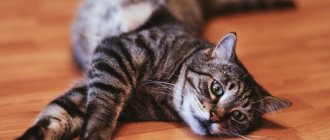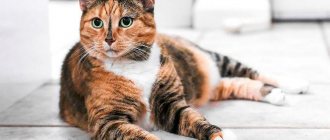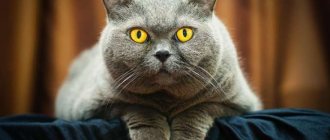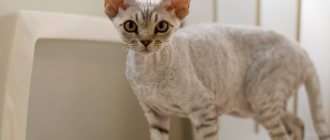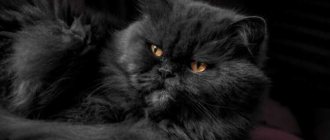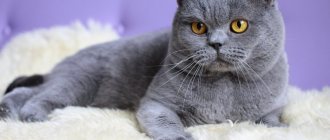What is ticking?
Cats with fur of this color really look very attractive and unusual. The fur coat of such pets does not have the usual stripes and at the same time it does not look monochromatic.
The ticked color of cats is also called “color without color.” In this case, the stripes are not located directly on the animal’s body, but on each individual hair. A cat with such fur looks as if covered with freckles. When such an animal moves, its fur seems to shimmer and shine. Many people believe that this coloring is very similar to the colors of squirrels or chinchillas.
Where to buy the kitten from the Whiskas advertisement
Whiskas for kittens: dry and wet food for cats
Today, buying a cat as advertised is not a big problem. Advertising contributed to the popularization of the breed. It is noteworthy that kittens of different breeds took part in various videos. So, for example, when buying a kitten from a Whiskas advertisement, you can choose from British, Scottish, American and European shorthairs. Outwardly, they are not much different from each other and will become family favorites for many years.
List of some popular nurseries engaged in breeding cats of these breeds:
- Al Blues (St. Petersburg);
- Allure (St. Petersburg);
- Hope Island (St. Petersburg);
- Sandi-Cat (St. Petersburg);
- Astropuss (Moscow);
- Britanic (Moscow);
- Brittish House (Moscow).
British Shorthair kittens are the most popular among breeders
Main characteristics of color
A cat's coat can only be recognized as ticked if:
- there is no extraneous pattern at all on the animal’s body, neither clear nor blurred;
- On each hair on the animal’s fur there are several dark and light stripes (at least 3 dark stripes).
The ticked color of cats, among other things, allows for stripes on the tip of the tail and paws, the presence of a “necklace” on the neck, as well as stripes in the shape of the letter “M” on the forehead. Such drawings are not considered a reason for disqualifying cats of any breed except Abyssinian.
Varieties of tabby pattern
Tabbed patterns are divided into 4 types, each of which contains its own genetic information.
The main ones:
- classic (marble);
- ticked (Abyssinian);
- striped (mackerel);
- spotted (leopard).
All other types of colors are mixed and combined with other colors.
Classic (Marble)
You can recognize a marbled cat by its large spots, wide stripes and interesting curls located on the back and sides. The area around the neck and paws is decorated with subtle graphic designs. This suit is the most beautiful and classic.
Ticked (Abyssinian)
Most often, cats of the Abyssinian breed have a ticked appearance, which is why this specimen is also nicknamed Abyssinian. Outwardly, it seems that there are no extra patterns on the animal’s fur other than a solid color.
Be sure to read:
Seal tabby point, seal point, red point, blue point - colors of Thai cats: characteristics, features of care and breeding
In fact, it is covered with stripes, lines, and small dots that are barely visible. They can be seen if you look closely. The pattern is located on the chest, limbs, tail and face of the cat, several tones darker than the main shade.
Striped
With a striped (tiger) pattern, the animal's fur is covered with vertical narrow lines running along the spine and spreading throughout the body. From the top point, the pattern diverges to the sides and branches.
The color of the tiger stripes stands out against the general background in contrast. This color is also called mackerel after the striped mackerel fish.
Spotted
Felinologists also call the spotted type of coloring leopard. The coloring is characterized by patterns that consist of spots and specks.
A drawing of a relatively dominant color may be bright or not very different in tone from the base. An animal with this pattern looks like a small leopard.
Types of ticked cat colors
In addition to Abyssinians, cats of the following breeds can have such coat colors today:
- Scottish and British;
- American Wirehair, Miniature, Shorthair;
- bobtail;
- American Curl;
- Persian;
- Maine Coon;
- Ceylonese;
- Devon Rex;
- munchkin and some others.
There are 9 main types of ticked colors in cats:
- black;
- cream;
- blue;
- chocolate;
- cinnamon;
- red;
- lilac;
- gold;
- faun.
Why is Whiskas the cat so popular?
Not all people are loyal to advertising on television or on the Internet. But, whatever one may say, it has become an integral part of the life of a modern person. Advertising is a time when the human brain perceives information primarily superficially, that is, literally lets it pass by.
Many people like the cat from popular advertising
But who doesn’t stop their gaze on the screen when the face of everyone’s favorite animal appears there? This adorable cat from a cat food commercial has won the hearts of viewers. Its characteristic, memorable color has long branded all cats of this breed as the “Whiskas cat.”
Cat breed from Whiskas food advertisement
When a person who is just thinking about what breed of kitten to get, he involuntarily pays attention to the options that are most accessible to the eye. Today these are animals from commercials. Then many people have a question about the breed of cat from Whiskas. The Whiskas cat is a British Shorthair breed.
Note! The color of the kitten in the advertisement is called silver tabby, and today this color is the most popular among British Shorthair cats. Perhaps this was facilitated by the extensive advertising of Whiskas with a cat of this breed in the leading role.
Black ticked color
The coding for this color is as follows: n 25. Cats with this color have a black pattern on a copper background. The nose and eyes of animals are surrounded by a rim. The color of this edging is dark. Cats have a brick red nose and eyes that can be any color, including green. Pets with such fur do not have only blue eyes. The paw pads of black ticked animals are brown or black as standard.
Color point
The Color Point is a rare breed of Scottish cat with a color similar to that of a Siamese cat. In childhood they look a little like Thai kittens. The main background is white or cream. The muzzle, ears, paws and tail are painted in darker shades. Color point or links point have blue eyes.
They acquired their colors from their British ancestors, who had Persians with this shade in their family. By the way, it is very difficult to distinguish a British cat from a Scottish one, and even professionals cannot always do this.
Red ticked
The coat of d 25 cats not only looks unusual due to the ticking, but is also very bright. The pattern on the body of such animals is deep red on a red background. The nose and mouth of ticked cats of this color are also surrounded by a rim of the same color.
The eyes of animals in this group can range in color from yellow to brown. The nose and paw pads are brick red.
Plain (solid)
The color of Scottish Fold cats is monochromatic and they should not have any other color. The fold-eared cat can be of the following colors: white and black, chocolate and lilac, blue and red, cream, fawn and cinnamon. The most popular color in the world among solid Scottish cats is blue. These are the majority of cats.
White
The white Scottish Straight cat can have different eyes, from blue and bright orange to rich amber and copper. Kittens of this variety remain white for the rest of their lives. If kittens have spots, then an adult cat remains white for the rest of its life.
Black
The Scottish Fold black cat is mostly bright in color. A couple of white hairs are acceptable, but if the cat has large red and brown patches, then it is not a purebred.
Black Scottish Fold cats should be bright black in color and their ears, like all fold-eared cats, should be pressed to the head, unlike straight-eared cats. A straight-eared black cat always has its ears erect.
Chocolate
The chocolate Scottish Fold looks impressive. The chocolate color is quite rare. Brown fold kittens should have a smooth, uniform coat of chocolate color. The dark brown coloring adds nobility to the cat.
A brown cat gets this color if he has chocolate, chocolate bicolor or chocolate color points in his pedigree. Chocolate Scottish kittens always delight their owners. They look very cool against a light background.
Lilac (lavender)
A lilac long-eared cat gets this color if he has either lilac color points or lilac in his pedigree. The lilac coloration goes well with orange, copper or amber colored eyes and a light brown nose. This color is also called coffee with milk.
Blue color (blue)
The Scots Blue can have a coat color of many shades of blue. Some cats may have a fur color closer to gray, and some closer to blue. Each hair must be saturated, then the coat will be perfectly blue.
Gold
This is the rarest and very beautiful color of cats with the coding ny 25. The background of the animals’ fur in this case is apricot, and the stripes on the hair are dark. The most common golden ticked color is found in British cats. According to the standard, the eyes of such pets should be emerald green. The paw pads, as well as the outline of animals in this group, are brown or black. The nose of cats of this color is brick-red.
History of the Scottish Straight breed
The Scottish Straight breed is the same as the Scottish Fold, only with a modified structure of the auricle. Simply put, folds are lop-eared, straights are straight-eared, without a characteristic crease. This is the only exterior feature that distinguishes straights from folds.
The Scottish Shorthair cat is considered the youngest breed. The first kitten with flattened ears appeared in Scotland on one of the farms in the 60s. The ancestor of the Scottish cat had no pedigree and was an ordinary cat that chased rodents around barns.
According to official data, the first breeder of the breed was William Ross, a peasant who took into care a kitten from a fold-eared cat. Later, breeders joined the breeding process. Experts noticed an interesting feature: kittens with straight ears periodically appeared in litters of purebred Scottish cats. They were in no hurry to separate them into a separate breed, since they considered straight ears to be a defect, and such kittens were not popular. However, nature itself entered the arena.
Soon, breeders noticed that attempts to consolidate lop ears as a breed trait led to a deterioration in the health of the animals. The gene that is responsible for flattened ears inhibits the function of the bone apparatus, which has led to thickening of the bones and osteochondrodysplasia. The breeders decided to look for “fresh blood” in order to reduce the number of genetic pathologies.
Using the outcrossing method, breeders found that the healthiest offspring are obtained from crossing a Fold female and a Straight male. It was this discovery that drew the attention of felinologists to the straight-eared Scots. In 2004, the Scottish Straight breed was officially recognized by members of the World Cat Federation, which in turn fueled interest in straight-eared cats. The official breed code is SFS71.
Interesting. Scottish cats love to stand on their hind legs, like gophers, looking at something interesting. Another favorite pose of these wonderful purrs is sitting on the sofa or near the wall, with their front legs folded over their belly and their hind legs spread out.
Blue wool
Such cats, belonging to group a 25, have fur of a warm beige background with blue ticking. The nose and eyes of these animals are outlined with a grayish rim. The paw pads of blue cats are deep pink. The nose is the color of a withered rose. These cats have yellow eyes.
Description and breed standard
Scottish Straights are often confused with the British, although the former are significantly smaller than their relatives from foggy England. The average weight of straights is 3-3.5 kg.
The head according to the WCF standard must be round. The forehead and cheeks are convex. Males have larger cheekbones and cheeks than females. The chin is rounded, firm, but not protruding. The whisker pads are oval and convex.
The nose is short and wide, slightly flattened, has a slight deflection and a pronounced base with almost no stop.
The eyes are round, expressive, large, widely spaced. The gaze is open, inquisitive. The color of the iris depends on the color of the coat. The most common eye shade is amber or orange.
The ears are small, erect, wide at the base. The tips are rounded and directed forward. The outer part is covered with thick short fur, the inner part is decorated with lush brushes of hard hairs that extend beyond the ear.
The neck is short and muscular, but not as massive as that of the British.
The body is long, wide, muscular, and tends to be rectangular in shape. The silhouette is soft, rounded.
The limbs are proportional to the body, of moderate length, strong, muscular. O-shaped or X-shaped deformation of the hind legs is not allowed.
Paws are oval-shaped with tightly clasped toes.
The tail can be long or moderate in length. Movable, reaches the middle of the shoulder blades.
The coat is short or semi-long, double, plush with a thick undercoat. The texture and thickness of the fur varies depending on the time of year and the color of the animal.
Exterior defects and disqualifying defects:
- semi-erect, overly wide ears with posture like the British;
- flattened forehead;
- pronounced stop;
- long limbs;
- small, oval eyes;
- short, sedentary tail with creases;
- cryptorchidism;
- twisted fingers.
Secrets of genetics
Breeders consider breeding ticked cats to be a difficult task, but at the same time very exciting. At the moment, experts have been able to identify only two genes responsible for this design of the fur of furry pets: Abyssinian and common ticking.
The first gene gives the animal's hairs ticking with the same frequency of stripes. In this case, coloring with triple zoning is considered ideal. Mandatory for such an exterior is, among other things, a stripe on the back of a slightly darker shade than the body color.
The general ticking gene does not give the number of stripes on the hairs and their distribution, but simply smoothes out the saturation in the cat’s color. The homozygous form of this U gene is capable of making the pattern on the animal’s body almost invisible. In a heterozygous one, a clear pattern is observed on the paws and tail, as well as a shadow pattern on the body. This gene has the peculiarity that it begins its work from the very birth of the kitten.
Nutrition
An important aspect of caring for Scottish Folds is food. Nutrition should be regular and balanced so that the pet is always strong. The best option is a harmonious diet based on natural ingredients.
You can also choose good bagged food. Experts and nurseries recommend a varied diet that contains both natural ingredients and cat food. You should always remember to drink regularly.
The water in the bowl should be renewed daily, no matter how much you drink. It is normal for adults to eat 2-3 times a day. You should not change the types of food frequently, so as not to get a stomach ache.
It should be remembered that cats are contraindicated from eating foods with a lot of fat, with vinegar and salt, fried foods and containing sugar. Seasonings and hot and cold foods should be avoided.
Good for Scottish Folds:
- lean meat;
- fish;
- milk;
- cottage cheese.
Vegetable ingredients, fresh and boiled, and all sorts of cereals are needed.
It is not advisable to give:
- eggplant;
- tomatoes;
- onion;
- garlic.
Character of the Lilac Scotsman
Tortoiseshell and marbled Scottish Fold kittens are no different from their counterparts from other color groups. They are good-natured and affectionate, love company and do not seek solitude, get along well with other pets and get along well with children.
The lilac color combined with the marbled tabby pattern of the fold-eared breed is still considered rare and difficult to breed. It is suppressed by all upstream dominant genes and therefore a small number of breeders specialize in lilac cats. But at exhibitions, these pets are never left without attention, and Scottish kittens that meet all standard requirements do not wait long for their new owners. With correct breeding and proper care (feeding), cats live up to 15 years, which means they can bring people the joy of communication for a long time.
Content Features
Plush pets, like any cats, require proper care and proper nutrition. Before bringing home a Scottish kitten, the owner must purchase the following supplies for it:
- a small tray with low sides;
- bedding made from natural materials;
- scratching post;
- hypoallergenic toy.
It is necessary to begin raising an animal from the first days of the appearance of this fluffy ball in the house. Scottish cats are considered ideal pets. They easily make contact with all family members, having a special sympathy for small household members. Cats prefer sleep to active games. They are very attached to their owner and love to sit on his lap for hours.
The pet's sleeping place should not be located near a window or on the aisle. The Scots love warmth and comfort. They also do not like long walks in open areas. This breed is prone to being a homebody. For cats, various structures, such as stairs or shelves, are of great interest.
Scottish cats eat premium or super-premium food. They are highly digestible and rich in vitamins and minerals essential for cats. Natural foods are also suitable for Scots: lean meat, cereals, boiled fish and vegetables. The diet of kittens should be varied. And at the same time, babies should not be overfed. An overweight animal begins to move little and subsequently acquires a number of dangerous diseases.
Cats with short hair are brushed no more than once a week. This procedure is carried out using special brushes and combs. Bathe your pet as needed, and keep your ears and eyes clean every day. Scottish kittens are characterized by increased lacrimation, so the owner needs to stock up on special drops from the pet store.
The following video will tell you how to choose a healthy Scottish kitten.
Breeding
Breeding Scots should be left to breeders and nurseries. If pairs are crossed incorrectly, there is a high probability of getting sick offspring or animals whose defects will appear in the next generation.
Puberty
Maturity in animals occurs by the 8th month of life, however, a cat or male cat that has reached the age of 1.3 years is allowed to breed. Early pregnancy in animals leads to various birth complications, loss of litter, and reduced fertility.
Meeting with a partner
The cat meets her chosen partner on the second day of estrus, on the cat's territory. On the first day, the animals get to know each other, and skirmishes and conflicts are possible. The breeding partner must meet the WFC criteria to produce healthy offspring. To improve natural characteristics, animals of identical colors are mated; for example, you should not mix blue color with cinnamon, since in such cases the offspring are tortoiseshell in color, with heterochromia.
Mating of a fold-eared cat occurs only with Scottish Straight cats and, conversely, a fold-eared cat meets with a cat with erect ears. Sometimes it happens that fertilization does not occur after the first meeting of animals. It is advisable for the cat to stay with the cat for three days.
Pregnancy
Pregnancy in cats lasts nine weeks. The first signs appear in the second and third weeks. The nipples swell, change color, and the cat consumes a lot of food. During this period, it is necessary to exclude fish delicacies from the diet and add more fermented milk products, including natural yoghurts. In the fifth week, the cat’s belly is quite round, and the animal has gained significant weight. The entire period before the onset of labor, the cat behaves calmly and carefully.
Childbirth
Before the birth begins, the pet will begin to look for a place. It is quite possible that she will love an open closet or drawer. It is advisable to prepare a large cardboard box for the cat, lining it with a warm blanket or a thick layer of fabric. During childbirth, as a rule, outside help will only be needed to wipe the kittens from birth mucus and cleanse the sinuses, mouth and eyes. The cat will do the rest itself.
There are from 4 to 6 kittens in a litter. During the first days of life, the mother actively cares for and feeds them. At this time, you should not touch the cat or try to pet the kittens; the animal will respond with aggression. When the cat gets stronger, you need to take it to a doctor for an examination, and if any problems are detected, immediately begin their treatment.
Aftercare
As soon as the kittens reach one and a half months of age, the babies should be registered in the club. The establishment records all the characteristics of the kittens: gender, body size, color, and so on. Then you need to get a veterinary passport for the kids and get all the necessary vaccinations.
It is advisable to sell animals when they are adults, around 4-5 months of age. During this period, they will learn how to behave correctly with a person, where their place is, a tray, and they will learn to eat natural food or dry food.
Choosing a name
The animal's name should reflect its nature, character traits or appearance. These are usually the main criteria. It’s good if the name contains hissing sounds: this will help the animal quickly get used to its nickname. Her choice depends solely on the owner’s imagination. The name should be short and easy to pronounce: this will be more convenient for both the owners and the animal. There are a number of suitable nicknames for boys.
- You can name a cat by a traditional cat name: Fluff, Plyukha, Iris, Bow, Busik.
- Sometimes an animal is called by a human name. You can choose a noble name to match your pet: Leopold, Sylvester, Archibald.
- A purebred cat would be nicknamed Winston, Zorro, Raisin, Marquis.
There is also a choice for girls:
- based on its external features, you can give it the touching nickname Nochka, Lapka;
- the cat will remember cute words with hissing sounds: Ixi, Christy;
- The beautiful name Agrafena (Pear), Taisiya (Tasya) would be suitable.
You will learn more information about the Scottish Fold cat breed from the following video.
